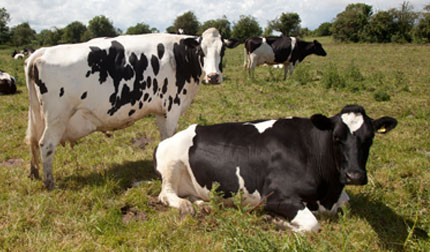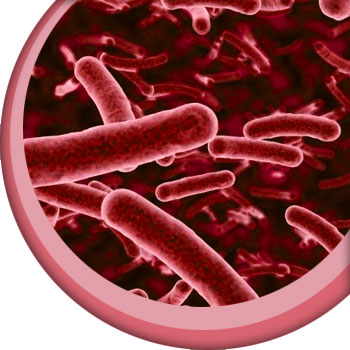Importance of
Antimicrobial Resistance
Antimicrobial resistance and the responsible use of antimicrobials has been a common topic of discussion amongst health professionals in recent years. Escherichia coli is the most important human pathogen worldwide, and yet some strains of E. coli are now resistant to all available antimicrobials.61 This is just one example of a massive global problem facing human health, and with no major advances in development of new antimicrobials likely in the next 10 years,61 urgent attempts are being made to address the issue.
Antimicrobial resistance in human pathogens has important consequences both medically and economically. Infection with a resistant strain of bacteria can increase mortality rates in hospital patients; for example in patients with pneumococcal pneumonia, penicillin resistance is associated with higher mortality rates.62 Data collected between 1996 and 1998 in Canada demonstrated cost per patient of treating methicillin-resistant Staphylococcus aureus (MRSA) as $14,360.63 In the EU about 400 000 people present with a resistant infection every year, and an average of 25 000 of these people die.46 The cost of this problem in the EU is estimated at more than €1.5 billion each year.46
Importance in Veterinary Medicine
Antimicrobial use in veterinary medicine and its contribution to antimicrobial resistance is a hotly debated topic, and has been widely covered in the media, for example a BBC news headline: “MRSA: New strain of superbug found in cows”.47 The suggestion is that administration of antimicrobials to animals may select for resistance in both pathogens and commensals in these individuals, and that the presence of resistance in zoonotic bacteria may allow the spread of resistant strains from animals to humans. Opinion on the significance of this for human health remains divided, and it is suggested that there is little conclusive evidence available that the use of antimicrobials in animals may compromise the effectiveness of related medicines in man.79
Food producing animalsWhen considering therapeutic veterinary use of antimicrobials in food producing animals, there is currently some evidence to support the theory that antimicrobial use may select for resistance in commensals. A study in Japan concluded that the overall usage of veterinary therapeutic antimicrobials contributed to antimicrobial resistance in E. coli isolates from faeces.66 Fluoroquinolones and 3rd and 4th generation cephalosporins have been shown to select for resistant Salmonella and E. coli in animals.61 However, not all studies are in agreement, with one study reporting that cephalosporin treatment of dairy cows could not be linked to emergence or amplification of antimicrobial resistance in E. coli isolates.68 In terms of the spread of this resistance to human bacterial isolates, again opposing evidence is found. In Denmark, for example, transmission of resistant Enterococci or resistance genes was shown to take place between humans, broilers and pigs.67 However, a recent study in Scotland on Salmonella typhimurium DT104 established that the sympatric animal population is unlikely to be the major source of resistance diversity for humans.80 Further work needs to be done before concrete conclusions are made. Companion animalsIt is important to note that it is not only food producing animals that should be considered; companion animals may also play a role in this problem. Transmission of both coagulase-positive Staphylococci69 and multidrug-resistant E.coli 70 between dogs and their owners has been shown to be possible, and pets belonging to human MRSA patients can be positive for MRSA.71 It is suggested that pets may therefore have a part in interspecies transmission of resistant bacteria. In addition, antimicrobial treatment of dogs and cats has been associated with significantly higher resistance rates to ampicillin and enrofloxacin in faecal isolates of Enterococci from these animals.72 Further work is needed in this field to determine the significance of these factors to human health. Antimicrobial resistance in bacteria is also a primary problem within companion animal medicine, with one of the best known cases being that of Bella Moss. Cases of methicillin-resistant and multidrug-resistant Staphylococcal skin infections are becoming more common in small animals,64 and multidrug-resistant Klebsiella pneumoniae have been isolated from urine samples of pets following urinary tract surgery.65

What can we do?
It has been recognised in the European Parliament Resolution on antimicrobial resistance that animals need antimicrobials to protect their health and welfare.80 However, it is important that as a profession we try to do what we can to help reduce the risk of antimicrobial resistance developing, both for animal and human health. As part of this we can adopt the “One Health” approach in which cooperation and collaboration between physicians, veterinary surgeons and other scientific health and environmental professionals allows greater improvements in health for all species.73
Within an individual veterinary clinic the most important factors are:
• Rational use of antimicrobials to reduce selection for resistant bacteria, both in pathogenic species and commensals. Click here to find out more about appropriate use and choosing an antimicrobial.
• Maintaining high standards of hygiene, both to minimise the spread of resistant bacteria between patients, and to reduce rates of exposure to infection. Also to reduce the risk of practice staff contracting zoonotic infections. Find out more.
It is also important to consider those antimicrobials important for human health. Fluoroquinolones and 3rd and 4th generation cephalosporins are often the main focus when discussing antimicrobial use in veterinary practice and the development of antimicrobial resistance, but it should be remembered that other antimicrobials play an equally vital part in human medicine and that all antimicrobials should be used responsibly and appropriately. The highest priority critically important antimicrobials for human medicine identified in the WHO report 2011 were fluoroquinolones, 3rd and 4th generation cephalosporins, macrolides and glycopeptides.61 The aim of this report is to help identify those antimicrobials most important to human health, and to enable strategies to contain antimicrobial resistance to be implicated through prioritisation of risk management among antimicrobials. Highest priority critically important antimicrobials are those that meet certain criteria as outlined in the report:61
• An antimicrobial agent which is the sole available therapy to treat a human disease, or one of limited availability
• An antimicrobial agent which is used to treat diseases caused by organisms transmitted to humans from non-human sources, or diseases that may acquire resistance genes from non-human sources
For example macrolides feature because:
• They select for macrolide-resistant Campylobacter spp. in animals61
• They are one of few available therapies for serious Campylobacter infections in children61

Disclaimer: Indications and doses may vary between products. The antimicrobials listed may constitute an off licence use of the product and as such should only be used according to the ‘Cascade’, further details of which are available on the RCVS, VMD and NOAH websites. Veterinary surgeons are advised to carefully check the Summary of Product Characteristics (SPC) before prescribing a product and obtain informed owner consent where required.

